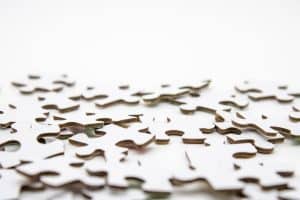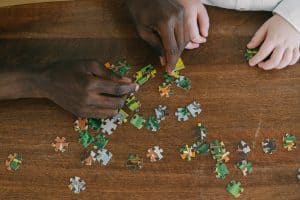In the world of jigsaw puzzles, where the pursuit of the perfect picture can be a delightful challenge, one often overlooked aspect is the art of puzzle etiquette. Whether you’re a seasoned jigsaw puzzler or just dipping your toes into this engaging hobby, knowing the dos and don’ts of jigsaw puzzle etiquette can greatly enhance your experience.
Jigsaw puzzles have gained immense popularity in recent years, with people of all ages finding joy in piecing together beautiful images, landscapes, and more. However, to ensure a harmonious puzzle-solving process, we must all make sure to practice good puzzle etiquette. In this comprehensive guide, we will explore the ins and outs of puzzle behavior, from choosing the right puzzle to celebrating your success, all while abiding by the unwritten rules of the puzzle community.
Choosing the Right Puzzle

One of the fundamental aspects of jigsaw puzzle etiquette is selecting the right puzzle. A well-chosen puzzle can significantly impact your enjoyment and that of your fellow puzzlers. Consider the following when making your choice:
- Complexity matters: When deciding on a puzzle, consider the skill level of the participants. For beginners, a small puzzle with fewer pieces might be a better choice. Experienced puzzlers may prefer more challenging, intricate designs.
- The size factor: Think about the space available for puzzling. Larger puzzles may require more room, both for assembling the pieces and for storage.
- The element of time: If you have a limited time for puzzling, choose a puzzle that can reasonably be completed within that timeframe. Picking a massive puzzle for a short session can lead to frustration.
Setting Up the Puzzle Space

Creating a conducive puzzle-solving environment is essential for a stress-free experience. To ensure that everyone enjoys the session, make sure the puzzle space is well-prepared:
- A flat surface: The foundation of a successful puzzle session is a flat, stable surface. This ensures that puzzle pieces fit together snugly and without interruptions.
- Good lighting: Adequate illumination is key to identifying piece details and colors accurately. Natural daylight or bright, adjustable lamps can make a big difference.
- Comfortable seating: Don’t underestimate the importance of comfortable chairs. You might be spending quite a bit of time at the puzzle table, so comfortable seating is greatly appreciated.
Inviting Participants
Jigsaw puzzling can be a solo endeavor, but it’s often more enjoyable when shared with others. If you’re planning to invite friends or family members to join your puzzle session, keep these points in mind:
- Choose the right group: Consider the puzzle’s complexity and the patience of potential participants. A 1000-piece puzzle might be too much for someone new to puzzling.
- Communicate your expectations: Let your group know the approximate time frame and your goals for the session. This way, everyone is on the same page.
The Dos and Don’ts of Puzzle Etiquette

Let’s delve into the nitty-gritty of puzzle etiquette, exploring the essential rules and behaviors that will ensure a smooth and respectful puzzle session:
- Respecting other participants’ space: Be mindful of others’ working areas. Avoid encroaching on someone else’s section of the puzzle.
- Communicating effectively: If you notice a piece that fits into someone else’s section, politely inform them, and pass the piece. Open communication is key.
- Handling puzzle pieces with care: Treat the pieces gently. Rough handling can damage or bend the cardboard, making it challenging for others to connect pieces accurately.
- Avoiding overly competitive behavior: While a competitive element can add fun to the experience, remember that the primary goal is enjoyment, not winning.
Time Management
Efficient time management is crucial to prevent frustration and burnout during a puzzle session. Here are some tips:
- Set realistic time limits or schedule puzzle sessions. Knowing when to take a break can refresh your focus and prevent burnout.
- Remember that jigsaw puzzling is not a race. Enjoy the process and appreciate the small victories along the way.
Solving Conflicts
Even with the best intentions, conflicts can arise during a puzzle session. Here’s how to handle them with grace:
- If a dispute occurs, take a step back, and discuss the issue calmly. Problem-solving should be as enjoyable as puzzle-solving.
- Always strive to find peaceful resolutions, and remember that in the world of jigsaw puzzles, there are no real winners or losers.
Celebrating Success
Completing a puzzle is a moment to celebrate. Here’s how to make it memorable:
- Showcase your finished puzzle. You can frame it, preserve it with puzzle conserver, or even take a picture to share with friends and family.
- Reflect on the enjoyable experience you had during the puzzle-solving process. It’s not just about the finished picture but the journey you took together.
Edge Pieces: The Cornerstones of Jigsaw Puzzle Success
Edge pieces are like the cornerstones of a jigsaw puzzle, forming the foundation upon which the entire image comes to life. However, their significance goes beyond just connecting the border. Here, we explore the role of edge pieces and how they contribute to a successful puzzle session.
Edge Pieces in Detail
Edge pieces are the ones with at least one straight edge. These are your starting point and should be sorted out before you even begin sorting other pieces. It’s a small piece of advice but a huge time-saver, preventing frustration as you puzzle together.
Working with Edge Pieces
One or two individuals may choose to work exclusively on the edges, creating the puzzle’s framework, while others delve into the puzzle’s interior. This approach is an excellent example of agreed-upon rules. It ensures that everyone is on the same page and offers a fresh perspective on the puzzle-solving process.
Avoiding Bad Puzzle Etiquette: Crafting Your Own Rules with a Fresh Perspective

While there are unwritten rules and agreed-upon guidelines in the world of jigsaw puzzles, crafting your own rules with a fresh perspective can add an exciting twist to the experience. Let’s delve into how a dash of innovation can be the key to avoiding bad puzzle etiquette.
The Art of Personalizing the Puzzle
Instead of rigidly adhering to traditional methods, consider allowing each participant to pick a piece or two of their choice to place in the puzzle. This personalization not only adds a unique touch to the puzzle but also fosters creativity.
Promoting a Fresh Perspective
Stuck on a challenging section? It’s okay to take a step back and invite another person to have a fresh perspective. This break from the norm can help you tackle the puzzle together with renewed vigor. Embracing a bit of flexibility in your puzzle etiquette can lead to a more enjoyable experience.
Final Thoughts: Jigsaw Puzzle Etiquette
In the world of jigsaw puzzles, observing good puzzle etiquette is just as important as finding that elusive edge piece. Remember that these unwritten rules are there to enhance the experience, not hinder it. By making sure your puzzle session is enjoyable, respectful, and in line with jigsaw puzzle etiquette, you’ll create lasting memories and build stronger connections with your fellow puzzlers.
Whether you’re new to jigsaw puzzling or a seasoned pro, adhering to these guidelines will not only make the puzzle session more enjoyable but also contribute to the overall growth of the puzzle community.
In the end, it’s not just about putting all the puzzle pieces together; it’s about creating a puzzle experience that’s both challenging and fun for everyone involved.
